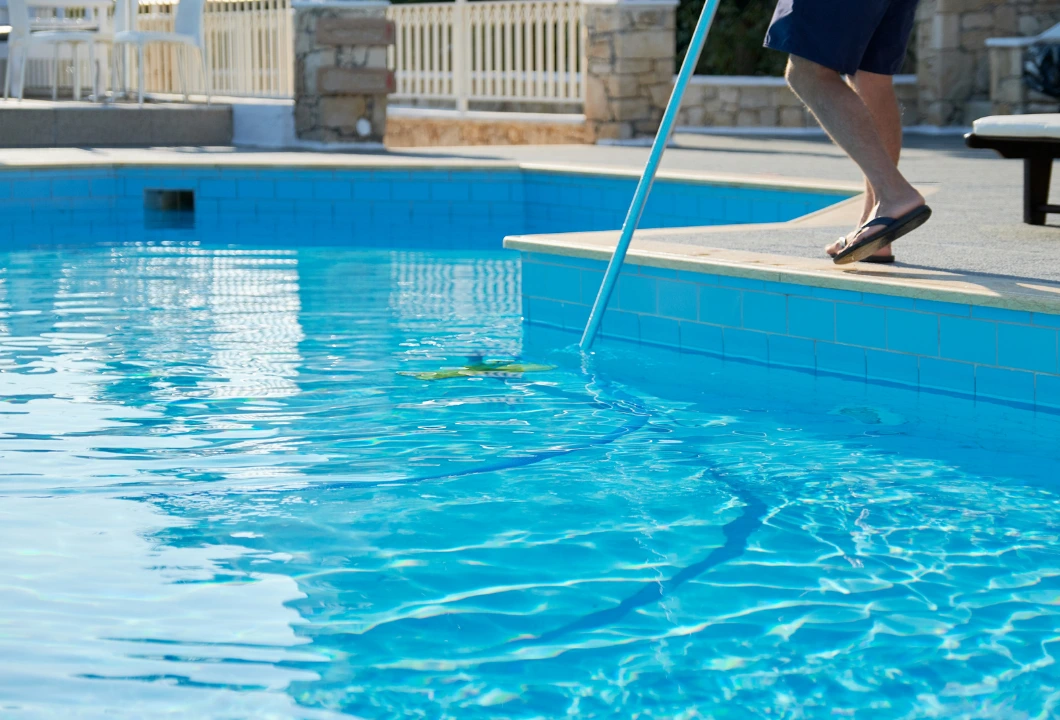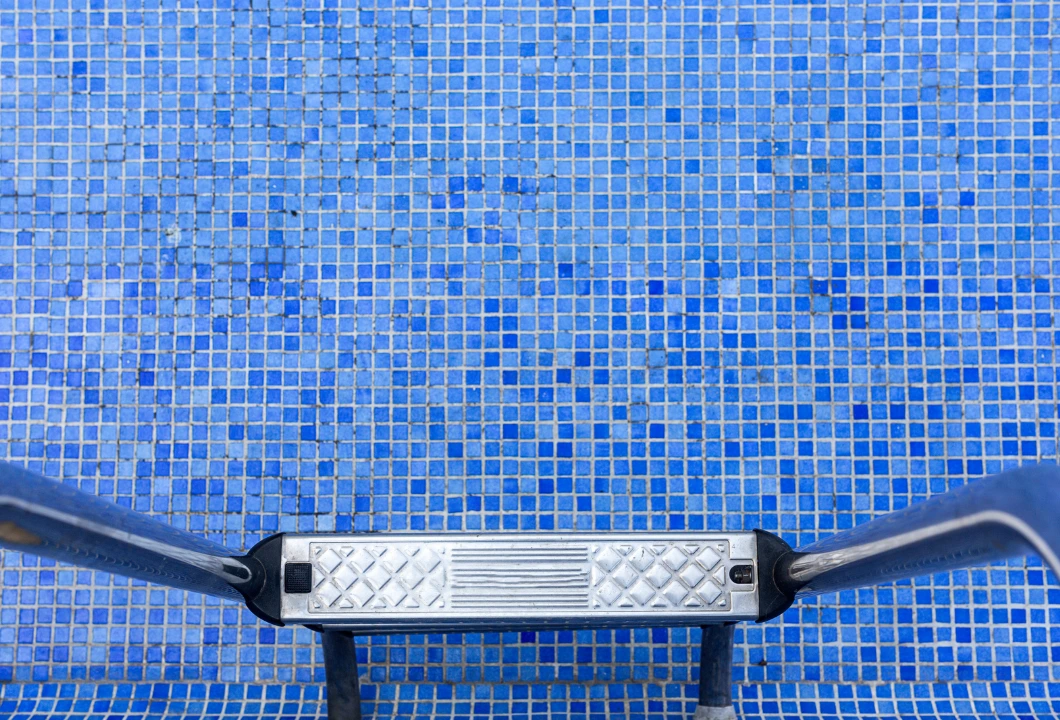In the past few blogs, we talked a lot about spring cleaning – why you should consider hiring professional cleaning services, home improvements to tackle this season, spring lawn care tips, and some other things. If you’re still working on ticking off every item on your list, make sure to not forget about maintaining your pool this spring.
Probably, you’re ready to jump into your swimming pool when you catch sight of the first sunshine after the long cold months. Don’t do it just yet. You need to spend some time first cleaning the pool before opening it. Even if you covered it in winter, there may have been some build-up or debris that made its way into your pool. How do I properly clean my pool after winter? There are a couple of steps you need to do first, such as doing an inspection, checking the water level, turning the pump and filter back on, vacuuming and scrubbing the pool, as well as balancing the pool water’s chemicals. We’ll dive in further about these things and also provide some all-year-round pool maintenance tips, so keep reading!
When is the ideal time to open the swimming pool after winter?

A good rule to follow is to open your swimming pool when the temperature is consistently over 70 degrees in the daytime. Don’t procrastinate and wait for summer before opening your pool. If you wait for the warmer months, algae will start growing in the pool.
Another tell-tale sign that it’s time to open your pool is when the water is around 54 degrees.
When you think it’s time to open and clean your pool, you want to prepare for a couple of things:
- Set a day to open the pool. Since it will take a chunk of your time to prep your pool, it’s ideal to schedule it on a weekend or for a few days if possible.
- Make sure to purchase all the needed supplies, including the test kits and chemicals for the pool.
- Do an inventory of the tools you’ll use to clean the swimming pool. Check your skimming net and vacuum and see if anything needs to be replaced.
- Clear out the nearby landscape. Make sure to cut overhanging branches, prune shrubs, etc. to avoid debris from falling into the pool and also prevent algae growth.
How do I get my pool ready after winter
As we mentioned earlier, there are a couple of tasks you need to complete to get your pool ready. The effort, amount of time, and cost of accomplishing these tasks depend on whether you correctly prepared your swimming pool for hibernation in winter. You can check our quick guide on pool service and maintenance for the cold months.
As for preparing your pool for spring *and summer*, here are the things to include in your to-do list:
Remove the pool cover
Obviously, the first thing to do is to remove the pool cover. Don’t try doing this on your own because you might risk getting all the debris on top of the cover into the swimming pool.
After getting the cover off start by washing it with soap and water and then hang it to dry. Only fold and keep the cover when it’s completely dry.
Do an inspection of the pool

When you’re done taking care of the pool cover, the next thing to do is to quickly check the pool. Keep an eye out for any signs of damage or if there are cracks, stains, loose tiles, or algae growth.When you spot even a small issue in your pool, be sure to get it fixed right away before it gets worse and more costly. If you’re unsure what to do and how to fix the issue it’s best to call an experienced pool repair service to address the issues.
If you’re in luck and don’t spot any issues in your swimming pool, then you can move on to cleaning the pool.
IMPORTANT REMINDER: DO NOT EMPTY THE POOL. Even if you’re tempted to do it so that you’ll have clean water, you’ll create a huge problem when you drain the pool’s water. Removing the water at the wrong time and in the wrong conditions can damage the swimming pool’s structure. Pool water should only be drained in emergency situations such as when there is major structural damage in the pool or there’s too much algae growth.
Remove equipment for winter
If you did winterize your pool, make sure to remove any winter equipment you may have attached some months ago. Pull out pool plugs, and remove ice compensators or other equipment that you used.
Check the pool’s water level
It’s normal to lose some pool water over the winter so make sure to check the level before you begin cleaning. Top up the pool with fresh water if the water is too low.
Ensuring that you have the right water level will help you balance the pool chemicals properly.
Inspect the pump and filter

The next thing to do is to give the pool’s pump and filter a tune-up. Inspect the filter, and see if there is dirt build-up or any damage. If needed, replace the filter (ideally, you should change this every 3 to 5 years). Also, don’t forget to check the open valves on the pump.If all looks good, turn on the pump and filter. Observe for a few minutes to see if there are leaks and the system is properly working. You can leave both running for a few hours to help clear out the debris in the pool. Again, with a good-quality pool cover, there wouldn’t be much dirt in the pool and it will be easier to clean.
Start to clean the swimming pool
After several hours of running the pump, you can start vacuuming the pool. Also don’t forget to use a pool brush to clean the steps, ladders, and the sides of the pool. Make sure you don’t miss anything, including the hard-to-reach areas.
You might notice that the pool will be filled with dirt that used to be on the floor. That is why you need to let the pump run for a minimum of 24 hours to circulate the water and filter out all the dirt. It’s also good to remember to clear out the filter baskets and cartridges a couple of times when doing this step.
Balance the pool chemicals

After running the pump for a whole day, it’s the perfect time to test the pool water chemistry. You have the option to get a water sample from the pool and have it tested in your local pool store or you can use test strips if you have any on hand.To give you an idea, here are the chemicals you need to check:
- pH level – the pH level of the pool water should be from 7.2 to 7.4. If the level is too low, you can add soda ash to increase the level, on the other hand, use bisulfate if the pH level is too high.
- Chlorine – the ideal chlorine level should be between 1 to 3 ppm. You can raise the levels of chlorine using tablets or granular chlorine, or with some liquid or powder shock. It’s better to be a bit conservative when adding chlorine as it will be easier to increase the level of chlorine than lower it.
If you put too much chlorine, you need to leave the pool uncovered and in direct sunlight to allow the sun to “eat away” the chlorine in the pool. Additional Tip: If the weather becomes hotter, make sure to frequently test the pool water frequently as the warm temperature can turn the color of the water into green because of lack of chlorine.
- Calcium – levels of calcium in the water should be 150 ppm to 250 ppm. The water in the pool will be too “soft” if it doesn’t have enough calcium. In such cases, you can use calcium chloride to increase calcium levels.
- Total alkalinity – the pool’s total alkalinity should be 80 to 120. If the alkalinity is too low, you can use sodium bicarbonate to increase it and muriatic acid if the level is too high.
Now that we’ve shared the steps on how to prepare your pool after winter, you can get ready to jump in!
You can also check out more of our tips below to help keep your pool clear and sparkling throughout the year.

- Regularly skim the pool – be sure to frequently remove the leaves, twigs, insects, and other debris in the water. This will ensure that your swimming pool is always ready to use.
- Run the pump adequately – for the pool water to circulate properly, make sure to run the pump for 8 hours (or anywhere between 6 to 12 hours depending on the pool’s size)
- Don’t forget to inspect the filter – make it a habit to check the filter if it’s working properly, and also clean it regularly.
- Frequently test the water – always check the pool chemicals and see if they are at the right levels so you can have a relaxing time soaking in the water.
- Vacuum the pool weekly – it’s not only when you do a major pool clean-up should you use the vacuum. In fact, it’s a must to vacuum your pool at least once a week. Also, don’t forget to brush the tiles and walls to prevent build-up.
Although having your own swimming pool in the backyard is a plus, it surely will take a lot of your time and effort to maintain it. If you feel like the upkeep of your pool is too much, you can always hire a professional pool service to take care of your swimming pool.
Want to have your pool ready for spring and summer? Find expert pool services near you! Click here.





